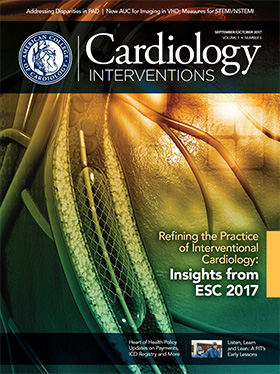Appropriate Use Criteria Published for Valvular Heart Disease Imaging Tests
New appropriate use criteria (AUC) released by the ACC and several other partnering societies focus on the evaluation and use of multimodality imaging in the diagnosis and management of valvular heart disease (VHD).
The criteria are divided into three primary sections: 1) initial evaluation for VHD; 2) prior testing; and 3) transcatheter intervention for VHD. They address a broad spectrum of clinical scenarios, some of which were included in former AUC documents and others, such as structural valve interventions, that the writing group notes “were not in the armamentarium of clinicians when prior single-modality documents were published.” An independent rating panel scored the scenarios, assessing whether the use of an imaging test for each indication fell into one of the following categories: Appropriate, May Be Appropriate or Rarely Appropriate.
Highlights from the document include:
Initial Evaluation
- In asymptomatic patients either at risk of developing VHD or in whom VHD is clinically suspected, transthoracic echocardiography (TTE) was rated appropriate for all indications. Three-dimensional (3D) TTE may be appropriate only in cases where reasonable suspicion of VHD or history of rheumatic heart disease exist. Transesophageal echocardiography (TEE), cardiovascular magnetic resonance (CMR) and cardiac computed tomography (CCT) were rarely appropriate for all scenarios.
- In symptomatic patients, echocardiography was the preferred option for initial testing in most scenarios. Exercise stress echocardiography may be appropriate for syncope patients, while CCT was given a similar rating for patients with respiratory failure or hypoxemia of uncertain etiology. TEE may be appropriate for patients with suspected infective endocarditis and positive blood cultures or a new murmur, while CCT, CMR and TEE all may be appropriate for patients with a suspected cardiac mass, suspected tumor or thrombus, or potential cardiac source of emboli. Most other imaging modalities were rated rarely appropriate in this patient group.
Prior Testing
- TEE was rated appropriate and TTE with contrast may be appropriate in evaluating native and prosthetic valves with inadequate images. TEE was also rated appropriate and fluorodeoxyglucose-positron emission tomography may be appropriate in the diagnosis of endocarditis in patients with a negative TTE.
- Low-dose dobutamine stress echocardiography was appropriate for patients with low-flow, low-gradient severe aortic stenosis and low ejection fraction, while it only may be appropriate for patients with preserved ejection fraction.
- Exercise stress echocardiography and dobutamine stress echocardiography were rated rarely appropriate in patients with severe, symptomatic aortic stenosis.
- Several scenarios address evaluation of mitral regurgitation severity. The TTE ratings are in line with prior AUC for echocardiography and “reflect the primacy of TTE at appropriate intervals.” Exercise stress echocardiography may be appropriate in evaluating patients with severe and asymptomatic aortic stenosis.
- For patients with new or worsening symptoms, TTE was rated appropriate and TEE may be appropriate in general scenarios. However, in the specific endocarditis scenario, both TTE and TEE are considered appropriate.
- In terms of postoperative imaging in patients with no symptoms undergoing surgical valve replacement and/or mitral repair, TTE (and in some scenarios TEE) with possible 3D is appropriate.
- CMR, CCT and 3D TTE may be appropriate in the majority of scenarios involving surgical valve replacement patients with suspicion of valve dysfunction.
Transcatheter Intervention
- Assessment for concomitant coronary artery disease is accomplished through CCT, myocardial perfusion imaging, single-photon emission computed tomography, positron emission tomography and angiography.
- Intraprocedural evaluation is accomplished with TTE, TEE, angiography and fluoroscopy. Because transcatheter aortic valve replacement (TAVR) procedures are increasingly being performed with conscious sedation, TTE is increasingly used in lieu of TEE. Both modalities are rated appropriate.
- TTE or TEE are appropriate for postprocedural assessment for valve dysfunction, while the use of 3D TTE, CCT or CMR may be appropriate.
- TTE is rated appropriate for assessment of stroke, whereas TEE and CCT may be appropriate. Brain imaging with CCT and CMR is also appropriate.
- Intraprocedural assessment accomplished with TEE was rated appropriate, as was the use of angiography/fluoroscopy except with the presence of mitral stenosis.
- The post-procedure assessment is currently determined by U.S. Food and Drug Administration regulations and involves echocardiography pre-discharge at one, six and 12 months and annually up to five years. TTE is rated appropriate and 3D TTE is rated may be appropriate.
"As imaging technologies and clinical applications continue to advance, the health care community must understand how best to incorporate these technologies into daily clinical care nd how to choose between new and established imaging technologies." — John U. Doherty, MD, FACC
“As imaging technologies and clinical applications continue to advance, the health care community must understand how best to incorporate these technologies into daily clinical care and how to choose between new and established imaging technologies,” says John U. Doherty, MD, FACC, chair of the writing committee.
The ACC/AATS/AHA/ASE/ASNC/HRS/SCAI/SCCT/SCMR/STS 2017 Appropriate Use Criteria for Multimodality Imaging in Valvular Heart Disease was published in the Journal of the American College of Cardiology. This document is the first of two companion AUC documents developed by these partnering societies. The second companion document, addressing multimodality imaging in structural heart disease, is in development.
Tweet this article: Tweet
 |
|
| Click the cover image above to read the latest issue of Cardiology: Interventions in e-pub format or click here to read it on the web! | |
Keywords: ACC Publications, Cardiology Interventions, Echocardiography, Stress, Echocardiography, Transesophageal, Myocardial Perfusion Imaging, Mitral Valve Insufficiency, Mitral Valve Stenosis, Rheumatic Heart Disease, Transcatheter Aortic Valve Replacement, Coronary Artery Disease, Conscious Sedation, Area Under Curve, Stroke Volume, Echocardiography, Heart Valve Diseases, Aortic Valve Stenosis, Endocarditis, Tomography, Emission-Computed, Single-Photon, Positron-Emission Tomography, Thrombosis, Stroke, Syncope, Angiography, Magnetic Resonance Spectroscopy, Fluoroscopy, Tomography, Hypoxia, Surgical Instruments, Respiratory Insufficiency, Neoplasms, Neuroimaging
< Back to Listings

